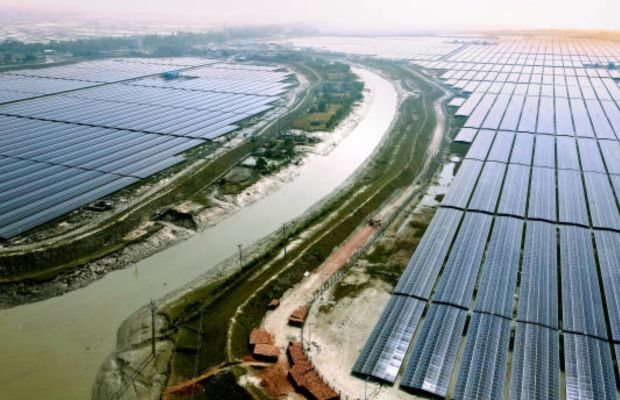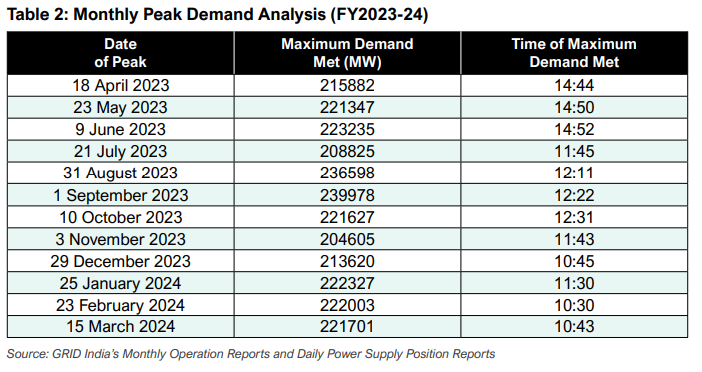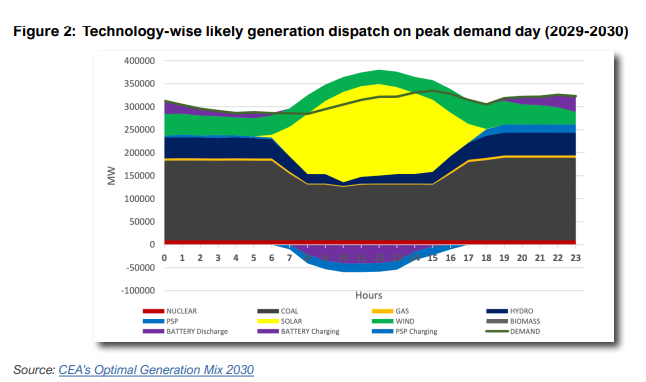Highlights :
-
IEEFA found that for June, the government forecasts peak demand at 240GW in May during the daytime and 235GW in the evening.
-
This indicates a constant increase in peak demand, which has risen by almost 150% from FY2017-18 to FY2023-24.

IEEFA Report Forecasts Diminishing Role of Gas In India’s Peak Electricity Demand
The Institute for Energy Economic and Financial Analysis (IEEFA) in its recent report found that new and cleaner options could soon replace the role of gas-based power in meeting peak electricity demand in India. India’s peak power demand, which, according to government forecasts, is likely to cross 350 gigawatts (GW) by 2030.
The IEEFA in its recent briefing note explained that since the recovery started after the COVID-19 lockdowns, India’s electricity demand has surged. The report found that for June, the government forecasts peak demand at 240GW in May itself during the daytime and 235 GW in the evening. This indicates a constant increase in peak demand, which has risen by almost 150% from FY2017-18 to FY2023-24. The government expects demand to hit 260GW in FY2024-25.

Monthly Peak Demand Analysis (FY2023-24)
Peak power demand trends and analysis found that the peak demand months and timings from 2019 onwards indicated a shift of peak demand to daytime when solar power is available. Moreover, the maximum requirement is also shifting to the months when wind power is more widely available. Notably, 70% of the wind power generation in India happens from May to September, coinciding with the southwest monsoon.
The study undertook data for FY2023-24 into consideration for a more granular observation. It also showed a shift of peak to daytime with the highest peak demand registered during the year was 240GW on 1 September 2023. Thus, while in the short term imported coal and gas-based power are helping the government meet peak demand, the shifts highlighted above make solar, wind, and storage more viable options in the coming years. The peak power reached as high as 216GW in April 2022 was unprecedented for India and it resulted in a shortfall in peak demand met by almost 8,500 megawatts (MW).
Peak Demand
The peak power high of 216GW in April 2022 was unprecedented for India and it resulted in a shortfall in peak demand met by almost 8,500 megawatts (MW). Consequently, the government took proactive measures in the summer of 2023 by inviting tenders for supplying gas-based power with minimum guaranteed offtake to meet the increase in peak demand. This power was to be offered in the Day Ahead Market (DAM) or the High Price – Day Ahead Market (HP-DAM), which started on 10 March 2023. Alternatively, it was to be offered in other power exchanges, including the tertiary reserve ancillary services (TRAS) mechanism, if not on DAM/ HP-DAM.
The price ceiling for HP-DAM was set at Rs50 per unit (US$0.60 per unit), which was later revised to Rs20 per unit (US$0.24 per unit), owing to tepid trade. Torrent Power emerged as the lowest bidder at Rs13.70 per unit (US$0.16 per unit) price to supply 770MW from two of its gas-based projects in Gujarat.
Based on the minimum guaranteed offtake of 233 million units (MUs), this cost NTPC Vidyut Vyapar Nigam Ltd. (NVVN), the tendering agency, a minimum of Rs4.2 billion (US$50.5 million). During the crunch period of power supply, apart from 17 April 2023, when the market clearing price (MCP) in HP-DAM touched Rs20 per unit (US$0.24 per unit) and on 13 May 2023 when it was Rs13.77 per unit (US$0.17 per unit), the MCP was lower than the quoted gas price with trade being limited due to the unprecedented rains and low temperatures during the period, making it difficult for NVVN to recover the minimum guarantee from the power sale. Gama Infraprop secured a bid for 90MW at Rs14.9 per unit (US$0.18 per unit).
Diminishing Role of Gas in the Medium-Term
Diminishing Role of Gas in the Medium-Term CEA’s Optimal Generation Mix 2030, released in April 2023, notes that pumped storage and battery storage technologies will help in diurnal grid balancing during months when the supply of renewable energy is high.
The report identified the use of gas in a limited amount in the sectors with no competitive alternatives or where gas use supports renewable energy uptake or helps maintain grid flexibility. Gas-based power plants could be used to serve peak demand or provide grid-balancing ancillary services.
The figure below shows the technology-wise likely generation dispatch on a peak demand day in FY2029-30 in May 2029, which shows the share of gas, pumped storage, and battery in non-solar hours. A detailed reading of the graph shows the need for 5GW of gas-based capacity to meet peak demand during non-solar hours.
Battery storage Gains Prominence
CEA’s Optimal Generation Mix 2030 notes that the installed capacity of battery storage would be 41.6 GW. The requirement would vary from 22.6GW to 49.3GW across different demand scenarios modeled in the report. Battery storage is rapidly becoming less expensive and that would further limit the role of gas-based power in the country.
In March 2024, Gujarat Urja Vikas Nigam Ltd (GUVNL) concluded a bid for 250MW/500 megawatt-hours (MWh) standalone battery energy storage at a tariff of Rs0.449 million/MW/month (US$5,401.13/MW/month). This indicates plummeting battery costs as it is 58% lower than the tariff of Rs1.08 million/MW/month (US$12,991.58/MW/month) discovered in Solar Energy Corporation of India’s (SECI’s) 500MW/1000MWh auction in 2022. More than 22GW of standalone storage tenders (without renewable energy components) were issued in the calendar year 2023.

Technology-wise peak demand day (2029-2030)
During the crunch period from 10 April to 16 May 2023, when the first gas-based power tender was announced, only the market clearing price in the HP-DAM was above the winning bid of Rs13.70 per unit (US$0.16 per unit). Gas-based power plants have a limited role in meeting peak demand, even in the short term.
According to the CEA, renewable energy round-the-clock (RE RTC) supply is the way forward for achieving 500GW renewable energy capacity by 2030. Further, in the medium- to long-term, the increase in the commercial viability of battery storage and the availability of pumped storage will help eliminate the use of gas.



